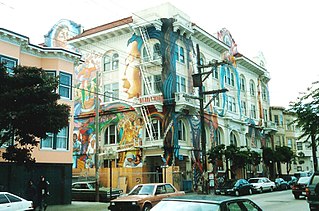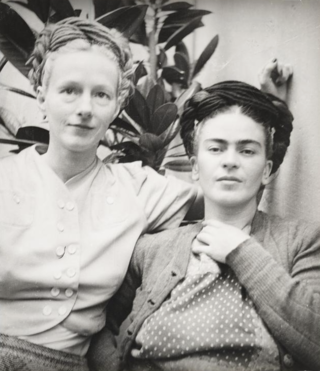The Mission District, commonly known as The Mission, is a neighborhood in San Francisco, California. One of the oldest neighborhoods in San Francisco, the Mission District's name is derived from Mission San Francisco de Asís, built in 1776 by the Spanish. The Mission is historically one of the most notable centers of the city's Chicano/Mexican-American community.

Precita Eyes Muralists Association is a community-based non-profit muralist and arts education group located in the Bernal Heights neighborhood of San Francisco, California. It was founded in 1977 by Susan and Luis Cervantes.
Clarion Alley Mural Project (CAMP) is an artists' collective in San Francisco's Mission District. The mission of CAMP is to support and produce socially engaged and aesthetically innovative public art, locally and globally as a grassroots artist-run organization. CAMP is a community, a public space, and an organizing force that uses public art as a means for supporting social, economic, racial, and environmental justice messaging and storytelling. The project is currently co-directed by Megan Wilson and Christopher Statton with a board of directors that includes Wilson, Statton, Shaghayegh Cyrous, Keyvan Shovir, Ivy McClelland, Kyoko Sato, Fara Akrami, Katayoun Bahrami, and Chris Gazaleh. Clarion Alley runs one block in San Francisco's inner Mission District between 17th and 18th streets and Mission and Valencia streets.

Balmy Alley is a one-block-long alley that is home to the most concentrated collection of murals in the city of San Francisco. It is located in the south central portion of the Inner Mission District between 24th Street and Garfield Square. Since 1973, most buildings on the street have been decorated with a mural.
Mission Muralismo was an artistic movement that brought awareness of issues as well as depicted everyday life as lived by the people in the San Francisco Mission District and other barrios around the world. The Mission was an artistic playground for muralists to speak out about injustices and social issues around their city, the country and the world. Latin American muralists voiced their cries for international attention and aimed to create awareness for the social and political problems of Latin America through the murals they painted. The Nicaraguan community especially contributed to artistic projects to shed light on the Nicaraguan Revolution and their struggles from 1979 to the 1990s.

Alma López is a Mexican-born Queer Chicana artist. Her art often portrays historical and cultural Mexican figures, such as the Virgin of Guadalupe and La Llorona, filtered through a radical Chicana feminist lesbian lens. Her art work is meant to empower women and indigenous Mexicans by the reappropriation of symbols of Mexica history when women played a more prominent role. The medium of digital art allows her to mix different elements from Catholicism and juxtapose it to indigenous art, women, and issues such as rape, gender violence, sexual marginalization and racism. This juxtaposition allows her to explore the representation of women and indigenous Mexicans and their histories that have been lost or fragmented since colonization. Her work is often seen as controversial. Currently, she is a lecturer at the University of California Los Angeles in the Department of Chicana/o Studies.
Juana Alicia is an American muralist, printmaker, educator, activist and, painter. She has been an educator for forty years. Juana Alicia, as part of the faculty Berkeley City College, founded and directed the True Colors Public Art program. Her sculptures and murals are principally located in the San Francisco Bay Area, Nicaragua, Mexico, Pennsylvania, and in many parts of California.

The Women's Building is a women-led non-profit arts and education community center located in San Francisco, California, which advocates self-determination, gender equality and social justice. The four-story building rents to multiple tenants and serves over 20,000 women a year. The building has served as an event and meeting space since 1979, when it was purchased by the San Francisco Women's Center. The building is shielded from rising real estate costs in the Mission District because that group has owned the building since 1995.

Emmy Lou Packard also known as Betty Lou Packard (1914–1998) was a Californian post-war artist known for painting, printmaking and murals.

Miranda Bergman is an American contemporary muralist born in 1947 and grew up in grew up in the San Francisco Mission District where she attended Balboa High School. Bergman is known for of the seven women artists who in 1994 created the MaestraPeace mural, the largest mural in San Francisco, which covers The Women's Building. Most of the murals created/co-created by Bergman straddles artistry and social activism, giving her a space to express both social struggles and cultural celebrations. She now lives in Oakland.
Barbara Carrasco is a Chicana artist, activist, painter and muralist. She lives and works in Los Angeles. Her work critiques dominant cultural stereotypes involving socioeconomics, race, gender and sexuality, and she is considered to be a radical feminist. Her art has been exhibited nationally and internationally. Her work was exhibited in the 1990-1993 traveling exhibition Chicano Art: Resistance and Affirmation.
Patricia Rodriguez is a prominent Chicana artist and educator. Rodriguez grew up in Marfa, Texas and moved to San Francisco to later pursue an art degree at Merritt College and this is where she learned about the Mexican American Liberation Art Front (MALA-F) and the Chicano Movement. In 1970, Patricia received a scholarship to the San Francisco Art Institute and this is where she met Graciela Carrillo. Together, they created and founded the Mujeres Muralistas, the first Chicana women's mural collective in San Francisco.
Edythe (Edy) Boone, is an African-American artist and activist. She has worked as a muralist, counselor, and art teacher throughout her life in an under-served area in California.

Susan Kelk Cervantes is an American artist who has been at the epicenter of the San Francisco mural movement and the co-founder and executive director of the community-based non-profit, Precita Eyes Muralists.

Precita Creek is a small creek in the Bernal Heights and Mission District neighborhoods of San Francisco, California. Its course is mirrored by the current Precita Avenue, which ran along the creek when it was laid out sometime during the early 1850s. The creek gets its name from precita, the Spanish word meaning dam or weir. The stream was buried before the beginning of the 20th century.
Margo Consuela Bors is an American painter, muralist, photographer and illustrator active in the San Francisco Bay area. She is an activist for protecting native plants and animals is supported by big organizations like the California Native Plant Society.
Marta Ayala is a Salvadoran-American painter and a woman muralist in San Francisco. Her work involves experimenting with colors, themes, etc. She is not tied to a single theme, medium or style. The majority of her work revolves around engaging with the community by collaborating together with other artists and teaching classes. She experiments with various colors and uses easily definable lines in her paintings and murals. Ayala's paintings and murals display a mix of colorful images reminiscent of childhood, earthly materials such as rocks and water with a mix of ancient culture. This is the reason for the word "primitive" to describe her work.

A Mexican American is a resident of the United States who is of Mexican descent. Mexican American-related topics include the following:
Irene Peréz is a muralist known for her membership in the Latina muralist group, Las Mujeres Muralistas and her contributions to the group mural Maestrapeace, at the Woman's Building in San Francisco, California.
Nancy "Pili" Hernandez is an Irish Chicana interdisciplinary artist and activist. Her art often portrays climate injustices, with a key topic being water pollution. Her artwork is intended to promote changes in climate policy, and spread awareness about climate change.







